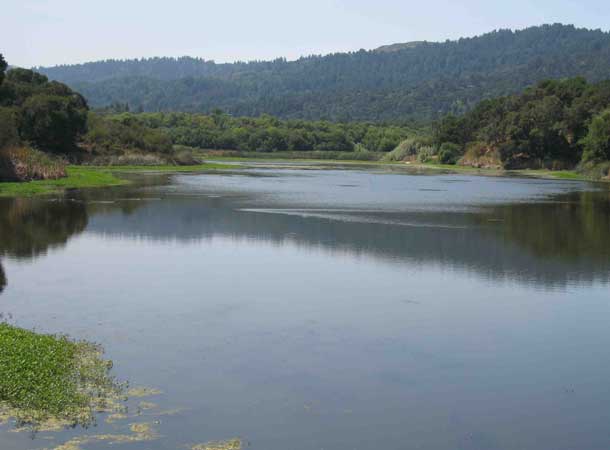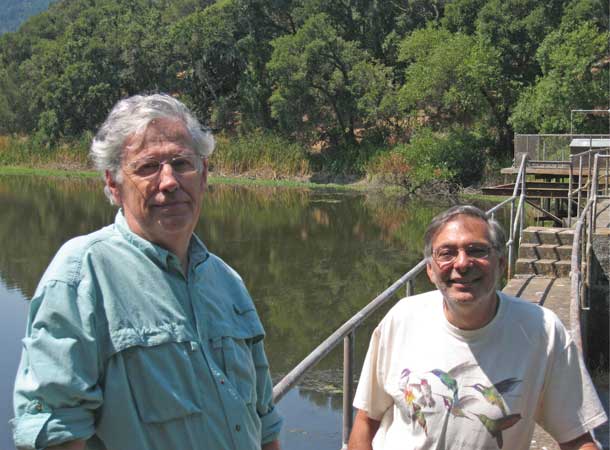A large steelhead trout makes its way to a gentle riffle in a sandy stream and deposits its milt over thousands of eggs. Cool water drifts by, draining to San Francisco Bay and then the ocean.
Or maybe a 100-year flood hits a newly restored watershed. Brown, roiling waters flush the stream-course, inundating homes, washing away photo albums, even taking human lives.
Are you ready to guess which fate would come to Palo Alto, Menlo Park, and East Palo Alto if the Searsville Dam is removed?
Well, you are invited to weigh in, should you wish to do so before August 30 at 5 p.m.
Here are some answers to the basics of a complex issue:
What and where is the Searsville Dam? What’s going on now?
The Searsville Dam sits in the hills above Palo Alto, on land owned by Stanford University. The dam and the reservoir behind it have become the site of controversy involving the university, government agencies, environmental groups, and endangered and threatened species. More than 3,000 letters have poured into the office of Stanford’s president. And now, federal agencies are soliciting public comments on a Habitat Conservation Plan (HCP) which, according to critics, improperly fails to mention the Searsville Dam.
Who’s in favor of dam removal?
Matt Stoecker is a biologist out of Portola Valley who runs the grassroots organization Beyond Searsville Dam. For more than ten years, the organization has been calling on Stanford to acknowledge that the dam is harming native species in the San Francisquito Creek watershed–both above and below the dam. Stoecker is pushing for an environmental assessment–if not complete removal–of the dam. “It’s clearly not sustainable,” he says. “The species here evolved in a free-flowing stream system, with migration up and down the river. The dam blocks migratory access, harbors exotic species, and is filling with sediment.” Indeed, the reservoir is 90 percent full of silt.
Is Stanford against removing the dam?
Philippe Cohen is the director of Stanford’s Jasper Ridge Biological Preserve, a research facility that encompasses Searsville Dam and Searsville Lake. David Freyberg is a Stanford engineering professor who has been studying the sediment and water of Searsville Lake since 1997. Neither Cohen nor Freyberg say they oppose dam removal, but both have lots of critical questions about removing Searsville Dam, which they suggest may have a string of unintended consequences. “This is a question of values,” says Cohen, “and my values are, first, to do no harm. Second, you must have enough information. The issues at play are sufficiently complex. How do you know that removal wouldn’t cause more harm than good?”
If it’s so complex, why the deadline?
Stanford is creating a Habitat Conservation Plan (HCP) for all of its properties, including Jasper Ridge Preserve and Searsville Dam, to be in effect for the next 50 years. Part of this process, legally mandated, is a public comment period. That period ends August 30.
The HCP is a legal agreement between Stanford and federal agencies–the U.S. Fish and Wildlife Service and the National Marine Fisheries Service–who are charged with protecting and regulating species protected by the Endangered Species Act. In this case, Stanford University must consider impacts of its activities on the Central California Coast steelhead trout, California tiger salamander, California red-legged frog, San Francisco garter snake, and western pond turtle.
Why didn’t Stanford include the future of the dam in their HCP?
Stoecker charges that Stanford hasn’t mentioned the dam in their HCP because it would force them to acknowledge the harm that the dam does to the federally listed steelhead trout. He demands that Stanford include the dam in the document. “They need to provide migratory access for different species, improve water quality, and allow adequate flow rate for habitat downstream,” he says.
“It’s not so simple,” says Stanford’s Philippe Cohen. “The HCP is designed for actionable items, ongoing maintenance, and specific projects. It’s not designed for an open-ended investigation like what to do with a dam.” David Freyberg says including such a giant task in the HCP would dwarf the already complex document. “It would preclude the HCP getting finished,” he says, “and would delay mitigation for other species.” That raises the prospect of harm to other listed species, says Cohen: “It would be a shame to spend all this time on removing the dam for the steelhead, and have one of the other species go extinct in the meantime.”
Say they remove the dam, what happens in a major flood?
Cohen and Freyberg are concerned what would happen in a flood. The San Francisquito Creek passes through affluent areas of Menlo Park and Palo Alto, but then meets the Bay in an alluvial fan in lower-income East Palo Alto. “Those are the folks that stand a greater risk for flooding,” Cohen says. “You need to consider what the risks are and who will be bearing those risks. Some people want to build the dam higher.”
To critics, that’s a short-sighted view. “Dams are coming out all across the country,” says Stoecker. “There’s a ton of funding–both public and private–for dam removal, and none for dam repair.” The funding, in addition to habitat restoration, has been used to improve flood protection downstream from dam removal sites. “The project on the Elwah River in Washington resulted in downstream protection from a 200-year flood,” says Stoecker.
But whether dam removal will work in this situation is still up for debate. “It was making decisions from a superficial place that got us into this situation,” says Freyberg, “and this shouldn’t be remedied with another superficial decision. There’s too much uncertainty. I would hope that as time moves on, not only do we make more decisions, we make better decisions.”
How do I comment and what happens with my comments?
You can comment to the U.S. Fish and Wildlife Service or the National Marine Fisheries Service. They will consider your comments in their assessment of Stanford’s HCP, which they’ll either approve or ask for revisions from Stanford.
All comments will be part of the administrative record and could be released to the public. You can request that your comments not be released, but the agencies make no guarantees.
Comments will be accepted until August 30, 2010, at 5 p.m.
The easiest way to send comments is by email to Stanford.HCP@noaa.gov (include the document identifier: Stanford HCP)
Read more about Standford’s perspective on managing the dam and reservoir.
And for more about the Beyond Searsville Dam, including a link to a comment template, visit beyondsearsvilledam.org.
The San Francisco Chronicle‘s Peter Fimrite did a fairly in-depth article on the controversy in June.
Or check out the full slate of documents from the Federal Register.

.jpg)



-300x199.jpg)
